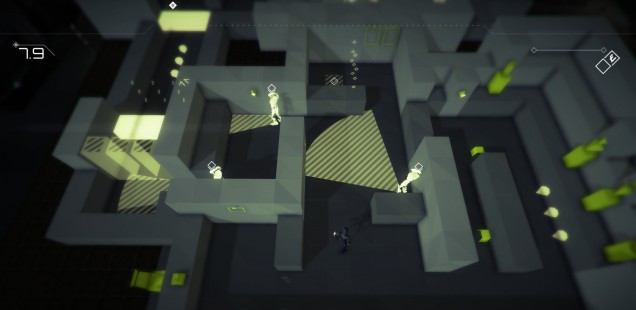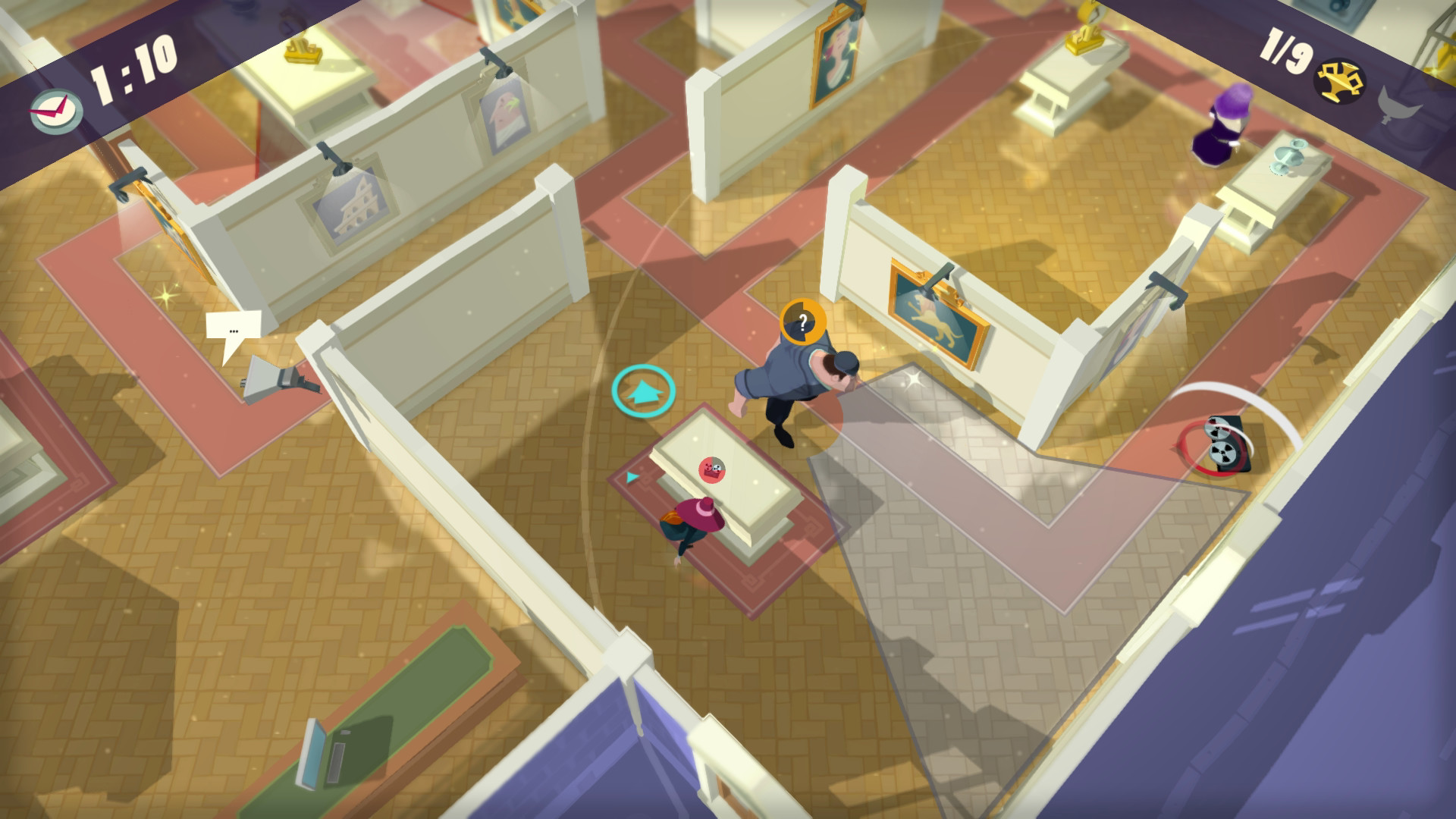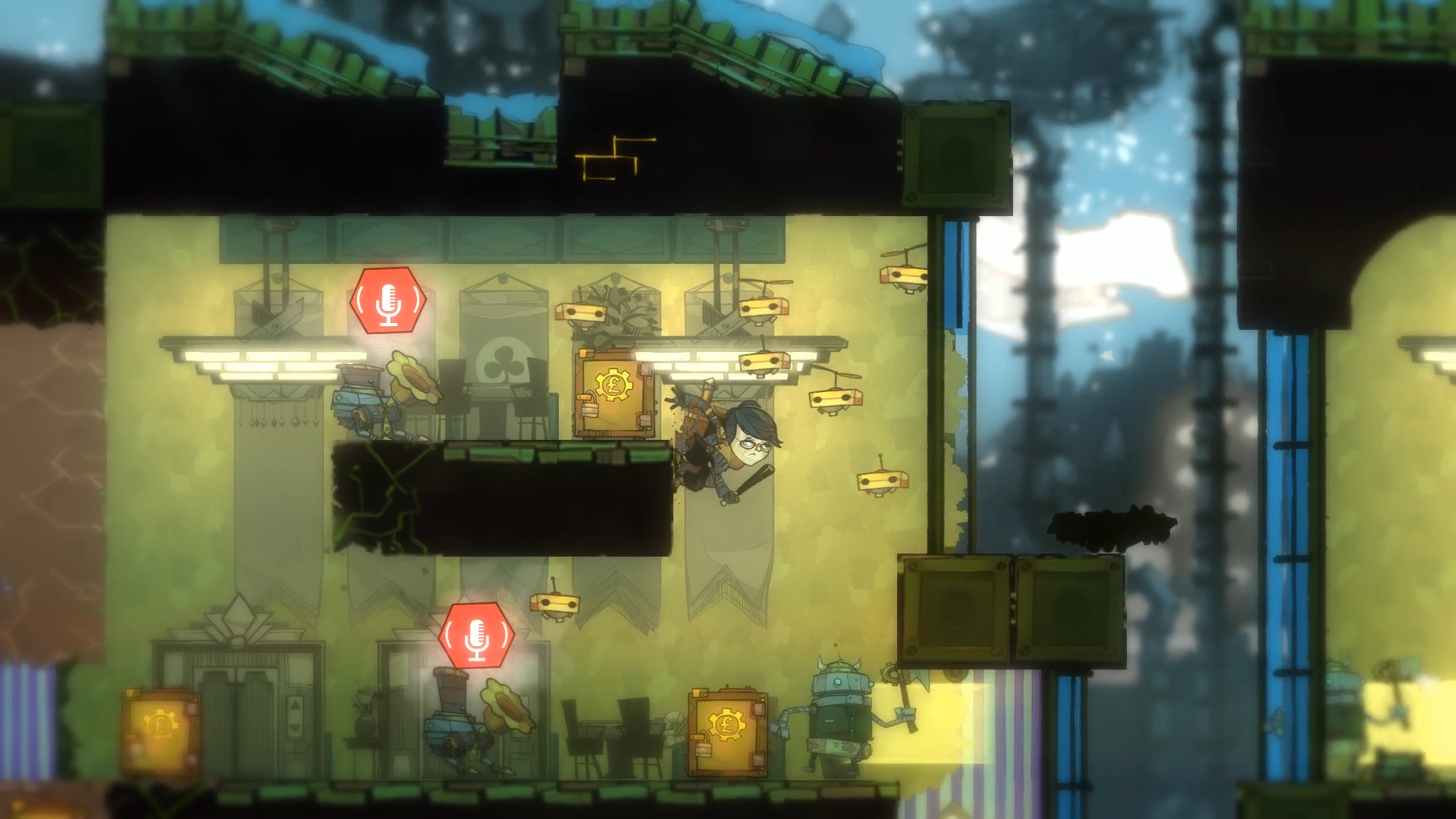
2015: The Year of Stealth
We need to be very quiet today with Volume, The Swindle, Neon Struct, Hotline Miami 2, and The Marvellous Miss Take.
Volume
In many respects Volume is more of a puzzle game than a stealth game. It lacks the flexibility of most stealth games, favoring one or two ways through its hundreds of levels that generally rely on timing more than personal choice. This isn’t a bad thing, though. It’s a game that compels you to keep moving, both through its levels and through the game itself. Visually it’s slick as hell, all angles and solid colors.
It tells an updated version of the Robin Hood tale in short chunks, enough to keep you curious but never too much to distract from its core focus on moving, always moving. It’s cool as hell but not pretentious about it, its earnestness inviting you to come in and try your hand, with community-created levels to explore or add to. It’s a fluid, sleek experience, all its touches deft and gentle, one worth checking out, as well as returning to as its offerings grow.
Riley MacLeod is the Managing Editor of Kotaku. His work has appeared at Offworld, Kill Screen, Unwinnable, Zam, and others.
The Swindle
The first thing to attract me to The Swindle was its visual style. All scratchy ink strokes, the characters and their surroundings look like they belong in a comic book about steampunk bank robbers. Instead they are in a game about the same topic.
The aim of the title is to stop a powerful weapon called the Basilisk, a device so powerful it will end all crime and the player only has 100 days to accrue enough money to level up and attempt the final assault. Each day is punctuated by an attempted robbery of a set of procedural generated levels that escalate in difficulty as you reach more profitable targets.
Like all roguelikes the appeal is learning the parameters of the game – the speed of patrolling guards, the radius of security cameras, when to cut one’s losses and escape with the loot they have got so far and when to push deeper. Each misstep, each outright failure teaches the player new rules. The upgrade system also opens up new possibilities.
It is the exhilaration of warping through a solid wall, to the safety of the outside, split seconds before I was caught by a guard; learning that I could use bombs to blast through floors and ceilings to give me a route through what had seemed like an impenetrable patrol; or hacking a drone for the first time and watching in delight as it took out an opponent I had no idea how to beat otherwise; all these things maybe push further into the intricacies of the game.
If I had any complaints it is that the jumping can occasionally be unreliable but it wasn’t enough to hinder me from booting the game on Christmas Eve to return to the slums and rob again, again.
AJ is a freelance writer and was a regular contributor to the soon to be missed Arcadian Rhythms. He can occasionally be seen on Twitter.

Neon Struct
Neon Struct is firmly aware of the heritage of stealth games that have come before it. There are clear echoes of Thief and Deus Ex in its Minecraft–like blocky world. The plot is pure cyberpunk spy thriller, with shadowy government organizations and big questions of freedom and surveillance. Every step it makes is confident, deliberate, and grounded.
One feature Neon Struct lacks, though, is a map. You find yourself dropped into a level with no objective markers, tasked with discovering your goals without guidance while avoiding guards, robots, and cameras. You don’t get any weapons, but the stealth is mercifully forgiving – providing you don’t run from a chasing patrol, get lost, and have to find your way back to a familiar landmark. This flexibility eases what can sometimes be an overwhelming tension in other stealth games, all the while providing room to experiment and explore.
The recent addition of a level editor and Steam Workshop support put the game’s strong systems and unique look into the players’ hands. I’ve meant to tinker around with it, but I keep getting drawn back into the game itself, wanting to improve just that one level, find that last hidden geocache, try the free expansion. Neon Struct is a stealth game that loves stealth games in all the best ways.
Riley MacLeod is the Managing Editor of Kotaku. His work has appeared at Offworld, Kill Screen, Unwinnable, Zam, and others.

Hotline Miami 2
It seems I’ve agreed to make the case for Hotline Miami 2. I admit, this game is a bit unwashed – there’s no way I can defend That Controversial Scene, and besides, for a game which seems so interested in its own story it’s filled with some truly awkward dialogue: “Only got a few more shots to shoot before we can move onto editing.”
Here’s the thing, though: this game is a good sequel, because both it and its predecessor would be diminished without the other. Critics pointed out that Hotline Miami seemed to be an argument against story-driven gameplay. The fugue state of constant action was more important than any explanation for all the violence, and all signifiers of personal history, like a mysterious Polaroid photograph that fluttered through the end credits, were left beguilingly without context.
So, here comes Hotline Miami 2 to make that more complicated. In this one, the gameplay is put in service of the story. Different playable characters behave very differently and encounter different kinds of level design to reflect their inner states. Sometimes this leads to fun twists, like the guy who (by default, at least) enforces nonlethal takedowns. Other times it’s boldly experimental. There’s a guy in a rat costume and the world just keeps kicking him while he’s down. Naturally, when you play as him, you face some seriously unfair situations. It’s harmonious!
It’s also surprisingly well-wrought and atmospheric, in a drug-addled Pynchon sort of way. Most players won’t be familiar with all the secret Hotline lore, because why would they be, but this story is surprisingly nimble in how it works whether you know the deal or not. Levels set in a Hawaiian warzone will either seem like a paranoid trip into an unsuspected alternate history or an origin story for the original game’s central relationship, and that’s a cool trick.
I like that Hotline Miami 2 didn’t play it safe. Dennaton were trying some things here, and instead of more streamlined arcade bliss they gave us something weird and wonderful. I’ll take that happily.
Joshua Trevett is a freelance writer and editor. He mostly likes art when it’s weird, and that goes double for videogames. That’s how he knows games are art. His writing can be found in publications like ZEAL and The Arcade Review. For secret reasons, it would be best if you followed him on just two out of these three social media sites: Twitter, YouTube, and his blog.

The Marvellous Miss Take
Stealth games have been constantly refined, their modes of interaction and movement simplified – from leaning around corners to peeking through cover – and their intersecting systems expanded upon – from primitive enemy routines to elaborate behaviors. Yet thematically, the reasons why one is sneaking have been mostly banal. “For the Thrill of the Kill!” shout Dishonored, Hitman, and recent Splinter Cell titles, reveling in sadistic, cliché stories. “To hide from the Jump Scare!” scream Amnesia, and its creepy-pasta brethren, evoking Lovecraft and asylum stereotypes for cheap thrills. With the exception of the Metal Gear Solid series, any kind of meaningful purpose in stealth games has been lacking.
Here’s where The Marvellous Miss Take shines most radiant. The game’s trio of playable thieves strive towards a noble goal: to take back unfairly bestowed paintings from a clawing capitalist, in the name of art and society. While the villain himself is mere mustache-twirling cardboard, the effect of his actions are distressing. Art is commodified for the elite, unfairly barred from the public’s eyes. But the game doesn’t dwell on dour seriousness. Through a brilliant top-down translation of Mark of the Ninja’s vision and sound cone based stealth, players sneak through sleek, vibrantly lit museums to a lively jazz soundtrack. Sneaking through these levels feels precise and fluid, making stealth a thrillingly poetic joy, evoking Splinter Cell: Chaos Theory’s beautiful physicality.
After every mission, we see the trio muse about their situation. Sophia Take’s shy altruism, Harry’s weary reflections of his past, and Daisy’s hints at a need for family are written with witty and delicate warmth, revealing an honest human core that feels invigorating in this age of easy nihilism. This couldn’t be more prevalent in how the game calls the option to go back to your level select area, the safe haven where the art you reclaim is stored: “Home.”
Stuart Arias is a freelancer based in Chicago, Illinois. You can read more of his work at Vida Honrada. You can find him rambling on Twitter.
